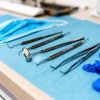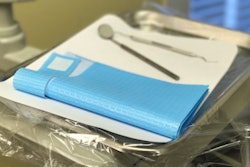
 Marie Fluent, DDS.
Marie Fluent, DDS.As dental teams review infection-control protocol and strive for compliance within their practices, one component of infection control often remains overlooked: the use of single-use disposable items. The prudent use of single-use disposable items eliminates many sources of cross contamination, while making infection-control applications of clinical personnel more efficient and safe.
A disposable, or single-use, item is designed to be used on one patient -- and only one patient -- then discarded. These items are not intended to be cleaned and sterilized for reuse on another patient. In general, they are not heat-tolerant and cannot be reliably cleaned, thus these items will not include instructions for reprocessing. Disposables are often labeled with the universal symbol for a single-use item (shown below).
 The universal symbol for a single-use item.
The universal symbol for a single-use item.Single-use devices were introduced into dentistry in the 1960s and promoted as being more convenient, safer, and efficient to use than reusable items. Reusable items require added processing, including cleaning and sterilization before reuse. These steps are time-consuming, introduce the possibility of operator error, and carry a risk of injury during cleaning and handling.
Single-use products are simple to store and retrieve, as they are often supplied in unit-dose sterile packaging. This in turn, makes operatory preparation and teardown quicker and easier.
Many dental hygienists and clinical personnel may recall a time when reuse of many items was much more common. Reuse of plastic saliva ejectors was the norm, and prophy cups were routinely washed and immersed in a chemical disinfectant or sterilant. As clinical advancements were made, the use of certain single-use devices, such as gloves and masks, became routine and mandated by regulations. Dental personnel more junior in their careers cannot imagine clinical dentistry without these single-use items.
Single-use items, however, have several disadvantages. As society gravitates toward becoming more eco-friendly, concerns arise regarding the addition of nonbiodegradable plastics to landfills. Fortunately, some manufacturers have recognized this and have begun to develop and fabricate biodegradable alternatives.
A second disadvantage is that some disposables may not function as well as their reusable counterparts. For instance, disposable air/water syringe tips historically leaked water, and plastic prophy heads were much less durable than reusable varieties. Once again, manufacturers have responded by researching, developing, and offering higher quality disposables according to the needs and specifications of clinicians. As a result, disposable syringe tips now offer the same air compression and tight water seal as the metal variety, and plastic prophy heads maintain the same torque and withstand similar pressure as metal prophy heads.
“Single-use products are simple to store and retrieve, as they are often supplied in unit-dose sterile packaging.”
A third disadvantage to disposables is cost. However, wages, time, and materials involved in decontamination and reprocessing also must be added in when considering the cost-effectiveness of an item. These often offset the cost of the disposable item. Thus, the continuous purchase of disposable items may, in the long run, be less expensive than a reusable version.
Certain dental products may be manufactured as either multiple- or single-use versions. For instance, metal impression trays may be cleaned and sterilized, but most plastic impression trays are considered single-use. Traditional prophy angles are multiple-use, yet the trend in dental hygiene is to use a disposable. Some polishing disks/wheels are reusable, whereas others are not. Many dental burs are now manufactured as single-use.
Although the tendency in these instances is to use the disposable variety, both reuse and single-use versions are acceptable. Confusion may arise since many of the reusable and disposable alternatives appear identical. Whichever product a dental office may use, observation to "type" of product and communication within the dental team is paramount. If in doubt whether a product is considered single-use, consult the manufacturer's instructions.
Newer products are now available in disposable alternatives. Disposable protective eyewear can be used for patient protection during dental or hygiene procedures and also come in designs for clinical personnel. Cost in this instance is a major advantage, as protective eyewear is often expensive. Another advantage is that this form of eyewear may be worn over prescription glasses, allowing the clinician to wear corrective lenses while providing adequate protection during clinical care.
Disposable bib clips eliminate cross-contamination risks and are more hygienic than reusable varieties. Studies have confirmed that bib chains and clips are difficult to clean and disinfect. In a 2013 study, researchers at Tufts University School of Dental Medicine wrote that "bib clips from the hygiene clinic demonstrated that, with the current disinfection protocol, specific aerobic bacteria can remain viable on the surfaces of bib clips immediately after disinfection" (Compendium of Continuing Education in Dentistry, April 2013, Vol. 34:4 [suppl]).
Clinically, bib chains often go missing between patient uses. (I'm convinced that a bib-chain gremlin randomly collects these items and removes them from the dental operatory between patients!) Disposable bib chains are easy to use and provide comfort to the patient during clinical care.
As dentistry progresses into the new millennium, the use of single-use items seems likely to evolve. While clinicians and manufacturers continue to communicate, products are likely to be introduced that are safer, more convenient, easier to use, technologically advanced, eco-friendly, and cost-effective. Many disposable products are already available for dental and hygiene procedures and, when used appropriately, they may enhance an infection-control program.
Marie Fluent, DDS, enjoyed more than 20 years of dental practice in Virginia, Maryland, and Michigan and is currently an infection-control consultant and speaker. She consults for the Ann Arbor Veterans Affairs hospital and is on the advisory committee for the Washtenaw Community College Department of Dental Assisting. Dr. Fluent lectures and presents hands-on workshops on the topics of infection control and Occupational Safety and Health Administration (OSHA compliance in the dental office.
The comments and observations expressed herein do not necessarily reflect the opinions of DrBicuspid.com, nor should they be construed as an endorsement or admonishment of any particular idea, vendor, or organization.



















